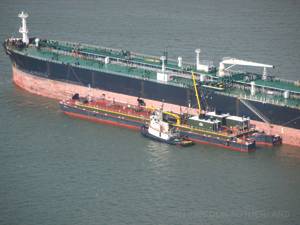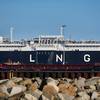New Barges for Short Sea City
The term short-sea shipping comes up aplenty these days, as the powers-that-be rediscover the practicalities and the economies of waterborne transport. The thinking is renewed and the interest revitalized, but for a lot of harbors nationwide it's deja vu. Take the island city of New York, and the multitudes of communities near and far that are joined to it by inland waters—the rivers, sounds, creeks, streams—all the way up to Albany, to Waterford and the Canal system, and to everything beyond that. There's nothing new about the short-sea shipping principle around here.
Before there were container barges there were railroad car floats, the same idea on rails. Before there were harbor-sized ATBs there were harbor tankers, wending through shallow waters from the big refineries of to terminals everywhere. The principles of short-sea shipping are woven into the fabric of history, all the way back to when sloops ruled the .
But as long as everybody's talking about it, thinking about it, re-evaluating, pitching its practicalities and economies against an emergency spreading nationwide, we should consider the factors that make it efficient. It's historically been better for some goods and products than land-based transport, but what about today? Has it gotten better still? Have we learned something from technology, or design, have we drawn from experience and raised the bar on performance?
At K-Sea, which has acquired a lot of new barges lately, Capt. Tom Sullivan, Vice President of Operations, tells us the new equipment brings plenty to the cause of efficiency.
"Our latest newbuilds, the 28,000-barrel units with the JAK couplers, are standardized. All the controls are in the same place and work the same way. The crews know everything to do, without hesitation." If that allowed getting finished in a shorter time, it would probably show-up as a form of cost-efficiency.
But the nature of a pinboat/barge, even a small one like the 28K-BBL "pocket ITBs" K-Sea introduced a few years ago contributes bigger things to the cause of efficiency. They can sail in rougher weather, for starters, and they can pump faster, so turnaround time is shorter. "With the older equipment it was easier for people to make mistakes, there could be more accidents," says Capt. Sullivan, "but now there's a computer program to tell them exactly when to start, what to do."
Pinboats can make-up and break-down in shorter time, without the delays and complexities of lines. And a lot of the time, if somebody gets hurt, it has something to do with lines. Capt. Sullivan notes that preventing one back injury could pay for the coupling system.
Land-Office Business on the Water?
K-Sea ordered eight 28,000-barrel barges from Bollinger, the last of which was due to be delivered while this article was being printed. Capt. Sullivan says that the new equipment, which will be used at K-Sea facilities in and as well as , partly represents an increase in capacity for the company, to serve a clientele that has grown. Of course, with the upper limit of OPA 90 now only six years away, a lot of equipment needs either to be rebuilt in double-skin form, or replaced altogether with the protective construction.
December 31, 2014 is coming at a fixed rate of speed, and at exactly that same speed more equipment is reaching its 35th birthday. Terminals have been adopting policies prohibiting barges over 35, which means the demise of plenty of old tonnage is coming from both ends. It seems to be regulation and policy that governs the survival of a lot of equipment, more than the merits of the equipment itself. It's probably not a bad time to own a barge-building facility.
For the owners, the situation requires putting-on their thinking caps and working-out some probabilities. Suppose, for example, they have a single-skin barge which by all estimations should continue working, making money right up to the stroke of 2015. Suppose, also, that it has a scheduled hauling two years before. And suppose inspection produces a need to spend a half-million to bring everything up to snuff. Will the barge earn enough in its stipulated last years to justify the expense? Is it the best economical wisdom to keep equipment on-line until the last possible moment, or is there an argument in favor of early termination and replacement by something better? People who play chess a lot are probably good at working it out.
At Reinauer they're developing an equipment strategy to recoup costs, barge superintendent Frank Kuziemski tells us. The fleet currently includes " thirty-five barges and growing" of which twelve are double-skin. The company's first Bollinger-built 28k-BBL barge, the RTC 26, was ready to go last September, but the decision was made to hold her voyage north for a month, by which time she could be joined in the tow by her new sister, RTC 27. "We were happy with the basic design Bollinger showed us," says Kuziemski. "I think maybe we wanted two generators where the standard design has one, and maybe we extended the boom."
The RTC 26 and 27 have JAK couplers, which for the moment are covered with plates while some of the company's perennials are converted to pinboats.
"The Dace and Steven and Morgan have been pinned, done by Feeney's up by . The Jo Ann is next."
A Little One
Only by modern standards would a 28,000-barrel barge be considered little. A lot of the harbor tankers of yore were under 20k-BBL, some even under 10k. But in an age when 300,000-BBL barges are part of the discussion, it seems that the scale of things generally has been ratcheted-up.
The little 28k-BBL barges (297.5 54 x 13-ft.) "are a design that we used to assist with some of the engineering and design," says Bollinger's Robert Socha. "They're classed Lakes, Bays & Sound (Inland) Tank Barges, ABS +A1 Oil Tank Barge, and USCG certified. We have also used the same design with a much simpler deck layout for inland operators." That was for Progressive Barge Line of New Orleans, "the exact same barge, but it doesn't have as much deck machinery, accommodation areas, doesn't have head, galley—it's a true inland clean oil barge."
The crewed versions ought to be comfy, as "the areas that are added have all the amenities of home -- office, galley, head, shower, most are at minimum three berths. They're utilizing them in , , and on the ."
There's sort of a romance surrounding 28k-barrel ATBs (or dual-mode ITBs, more officially) as they represent the adaptation of a system conceived for a much larger capacity under much more rigorous ocean conditions than we normally expect on harbors and rivers. The big ATBs proved themselves in the stormy , but the harbor gets sloppy too, and there have been recent reports of tankers getting wound-up in it.
Even on a fair day, the operational and economic advantages already cited for dual-mode ITBs apply to equipment big and small. K-Sea and Reinauer both chose JAK systems for their 28s, but the builder considers that the customer's decision—plenty of barges with Intercon and Bludworth couplers have come out of their yards.
While the pinned 28s are have their novelties, there's been no shortage of other new barges coming to . Of those built by Bollinger, both harbor and coastal work is represented by units like K-Sea's 105,139-barrel DBL 104, christened last summer. More recently, Energy 6508, Hornbeck's 60,000-barrel latest, delivered its first load to a customer early last month.
Less is More?
If a 28,000-barrel barge is "small" by contemporary standards, the new 38,500-barrel barges of Gellatly & Criscone Services might be termed "intermediate." The first was delivered by Bollinger in 2005, the second at the beginning of last year. has a 4200HP tug building for the company, delivery due before long. Bollinger is building two more barges for the company, one due next October-November, the fourth the following June-July. The design of the barges was a collaboration between Bollinger and his company, Capt. Alex Gellatly tells us, and he sees the result as an outstanding piece of work—"a not-cut-corners barge," as he sums it up.
Because of its design features, Capt. Gellatly tells us the barges can get into tighter spaces than the bigger ones with more payload than the smaller ones. The new ones are ocean-going, and the company calls up and down the seaboard. But their mainstay is around the harbor, contract and spot, and evidently the customer's impressed if you arrive on the job in a Cadillac.
Capt. Gellatly describes pumps that are a little more powerful than regulations require, larger containment boom than is strictly called for, an extra-large onboard crane that brings more self-reliance to the unit, alarm systems that are installed everywhere they ought to be, not just where the book says.
"We keep extra pump engines on skids." says Capt. Gellatly. "If one breaks down, we just uncover the hatch, and swap-out the engines with the crane. No outside contractors, no strain on the crane, no overloading. We're not trying to push the limit on any equipment we have. The pumps require 325 hp, we put a little over 400 hp in—we can move product that is cold, heavier. We can pump 36k bbl in 5 hours, very very respectable."
Capt. Gellatly describes his as a niche operation, when compared to K-Sea or Reinauer or Hornbeck, but he's also attuned to the niche nature the liquid cargo business has adopted. Low-sulphur diesel, low-sulphur kerosene, and ethanol are are all products that barges didn't carry years ago, and now are not products that easily pump-in right after a load of regular diesel has been pumped out. One of the things that comes natural to smaller units is the prospect of dedication, so "you can guarantee the customer product integrity."
Gellatly & Criscone has plans on the boards for even more barges, 50s and 60s, Capt. Gellatly tells us. But he expresses a concern undoubtedly shared by anyone building or rebuilding or repairing vessels. ", —they're buying everything up. The cost of steel is getting so exorbitant - from $200 a ton to $1100 a ton. I built a barge three years ago; and that same barge, identical, is now double. Double in cost—not an increase in barrel capacity at all. You can't charge enough to pay for what these things are starting to cost."
The short-sea shipping now on everyone's lips is part of the lifeblood of the region. The water never quit being a serious mode of transport because it's water that gets you to islands. The idea may be new in some places, but not in , nor in plenty of other harbor and river communities. Before they called it that, short-sea shipping was the established infrastructure. What may be newer are a couple things —how important it really is now for controlling the costs of things, for example, and the inflating costs it faces to make that effort.













